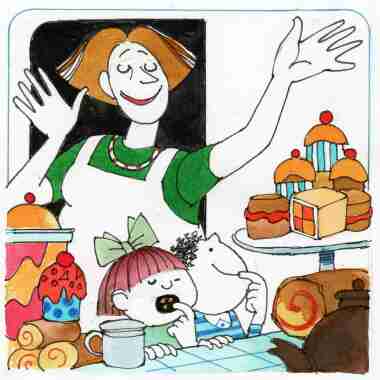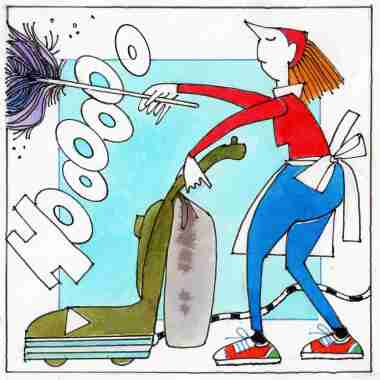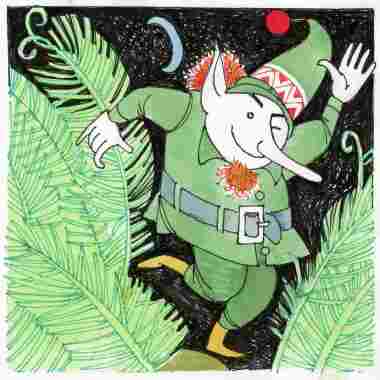Eat up, ye’re at yer aunties
EAT UP, YE'RE AT YER AUNTIES, n.
This wee phrase is defined succinctly in the Dictionaries of the Scots Language (DSL) as to
“help yourself liberally”.

This command to visitors (who are not necessarily visiting an auntie) makes a relatively late appearance in DSL. The first occurrence comes from Alan Spence writing in Streets of Stone: An Anthology of Glasgow Short Stories (1977):
“All the glasses were drained and set down empty on the table. ‘C’mon now people,’ said Tommy. ‘Get wired in therr!’ ‘Eat up,’ said Mary. ‘Yer at yer auntie’s!’”.
In the 1990s, a commentator from Argyll gave us:
“Eat up, ye’re at yer auntie’s: eat up!’.
Later, in January 2002, the Guardian made this interesting comparison:
“Further to Fritz Spiegl’s Liverpudlian adjuration to start eating (Letters, January), the Glasgow version is ‘Eat up, ye’re at yer Auntie’s’ - though why it should be grannies in Liverpool but aunties in Glasgow, I have no idea. My dad encourages diners with the words, ‘Stick in till ye stick oot!’, but then he’s a Church of Scotland minister (retired) so is naeb’dy’s auntie”.
The phrase remains popular among foodies, as seen in this September 2023 piece from the Scotsman:
“Never has the phrase ‘Eat up, you’re at your auntie’s’ been more apt than when visiting the Sisters restaurant in Kelvingrove as you really do feel like you’re visiting a favourite relative and by Jove will you want to eat what’s put in front of you”.
This Scots Word of the Week comes from Dictionaries of the Scots Language.
Visit DSL Online at https://dsl.ac.uk.
Trow
In the Dictionaries of the Scots Language (DSL) a trow is:
“A mischievous sprite or fairy, a supernatural being common in Scandinavian mythology from which it passed into Shetland and Orkney folk-lore”.
[Illustration by Bob Dewar]
They come in various guises and often seem positively dangerous. John Brand mentions their destructive habits in his A Brief Description of Orkney, Zetland etc. (1701):
“Sea-Trowes, great rolling Creatures, tumbling in the Waters, which if they come among their nets, they break them, and sometimes takes them away with them”.
According to The Scots Magazine of January 1949 they tend to have nocturnal habits:
“The fern, which is the floral symbol of Shetland, the trows’ homeland. In the autumn, at Hallowmass, folk had seen the ferry-kairds being parted, and the peerie [little] folk, or trows, coming forth on their nightly travels”.
Trowes are firmly established within the local culture and landscape. In June 1996, the Herald reported on an influx of rabbits causing problems in Orkney, with one islander saying:
“We are crying out for a Pied Piper who can vanish the rabbits forever over Fowl Craig or feed them to the trows beneath our North Hill”.
This connection with the landscape was taken up again in the Scotsman in June 2017:
“The rocks have been weathered over the years into curious shapes and have even been identified in Shetland folklore as Trowes who were caught out at daybreak and turned to stone!”.
Bear that in mind the next time you’re appreciating the picturesque scenery.
This Scots Word of the Week comes from Dictionaries of the Scots Language.
Visit DSL Online at https://dsl.ac.uk.
Snod
This useful word has many meanings in the Dictionaries of the Scots Language (DSL). As an adjective it can be paired with both people and things. Someone who is snod is
“neat, trim, spruce, [or] smart” whilst snod things are “tidy, compact, well laid out, [or] in good order”.

The term’s long pedigree dates back to the eighteenth century, with early examples occurring within Allan Ramsay’s poetry. In 1719 he uses it to describe someone as
“A Black-a-vic'd [dark-complexioned] snod dapper Fallow”,
whilst in 1721 it appears in the line:
“She kept her Housie snod and been”.
Tidiness and orderliness are clearly productive topics, as snod has given us many associated words during its history. In 1826, John Galt refers to a servant in the Last of Lairds as
“snodless, snoodless, and shodless”
to demonstrate their untidiness.
Seventy years later, we find reference to
“The merits o’ … different dressmakers an’ the snodness o’ their handiwark”
in Alick Blair’s Rantin Robin.
And in the twentieth century, Charles Murray mentions a
“snod dykit feedle [neatly walled field]”
in There’s Aye a Something (1933).
But is this once-popular term still used in the twenty-first century? Seemingly yes! It crops up in the Press and Journal in March 2023:
“A snod wee country kirk, blessed with an honest preacher and a gifted organist. The congregation were halfway through a hymn, singing with confidence, faith defiant against a dull culture of secularism and atheism. That was when the organist went silent”.
This Scots Word of the Week comes from Dictionaries of the Scots Language.
Visit DSL Online at https://dsl.ac.uk
Scabby-heided
A term to make your skin crawl! The Dictionaries of the Scots Language defines scabby-heided as
“infested with head lice”.

Matthew Fitt’s 1996 poetry collection Pure Radge contains a particularly memorable early example:
“scabbie-heidit, muckle-boukit [of large build], aye hingin, hootchin wi clart”.
In November 2000, the Daily Record demonstrated how the phrase could be used to describe indiscriminate hunger:
“Hungry? I could eat a scabby-heided wean with toenail clippings on the side”.
To each his own.
These examples beg the question, is there only late twentieth century evidence for the term? Apparently not! The Port Glasgow Express of November 1895 has the following exchange from a trial over a row between sisters:
“Stanton was the first witness, and he said he heard Mrs Sweenie calling her sister a scabbie headed —.”
Unfortunately, the exact nature of this insult will be forever unknown, thanks to the editor’s cautious redaction.
Back to the twenty-first century, in August 2013 a writer in the Daily Record reflected on their childhood television habits:
“In my lifetime, my relationship with the telly has changed drastically. Going from being wee and feeling utterly deprived of one, to now eking out time to catch up with only what I’ve already (I still say this) ‘taped’! For years, the only person in our street with a telly was Mrs Lyons, the hairdresser. Saturdays saw her house invaded by scabby-headed weans who were not only there to watch Doctor Who but also to get the Vosene and clipper treatment”.
Ah, nostalgia.
This Scots Word of the Week comes from Dictionaries of the Scots Language.
Visit DSL Online at https://dsl.ac.uk.
Torn-face
This handy term is defined in the Dictionaries of the Scots Language (DSL) as
“(a person with) a sulky peevish face. Hence torn-faced, sulky, glum”.
A surprisingly recent coinage, the first citation is from a correspondent in Angus in 1968:
“What a torn face ye’ve got”.
[Illustration by Bob Dewar]
DSL has many examples from the 1990s. The following from For Ever Yours Marie-Lou by Martin Bowmen and Bill Findlay (1994) is intriguing:
“We’re too auld tae start this cairry-oan again…You take it fae me, torn face, you’ll be eatin smoothy peanut butter fae noo oan! If you’re waantin tae feed that wean’s face, you better start saving the cents!”.
In 1998, Gordon Legge wrote in Near Neighbours:
“As she headed back to her desk a great big woman with a right torn face came storming in”.
However, the term is still very much with us. A writer in the Daily Record back in January 2005 remarked:
“Say to a taxi driver: ‘No I can’t guess who you had in the back of your cab last week, and what’s more, I don't care.’ Guaranteed tight lip and torn face for your entire journey”.
A similarly evocative description appeared in the National in June 2022:
“There’s something typically Scottish about this man. Maybe it’s his sense of unbridled resentment at the hand the world has dealt him, maybe it’s the way he has the same torn face for everyone he speaks to, maybe it’s because he has not so a chip as an entire fish supper on his shoulder”.
This Scots Word of the Week comes from Dictionaries of the Scots Language.
Visit DSL Online at https://dsl.ac.uk.

